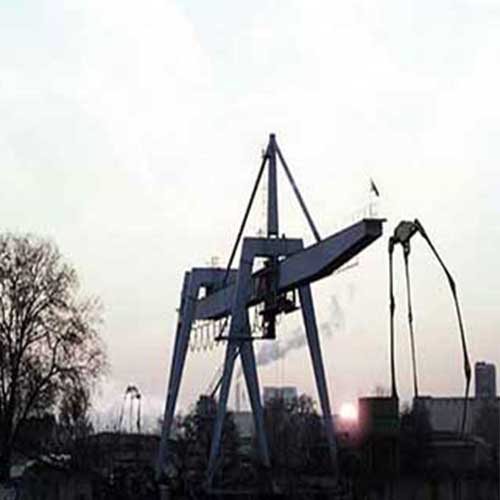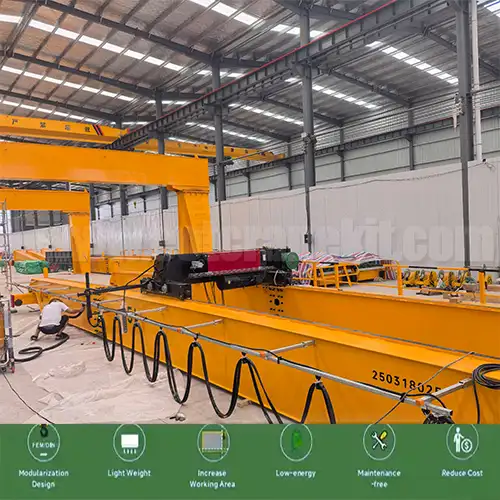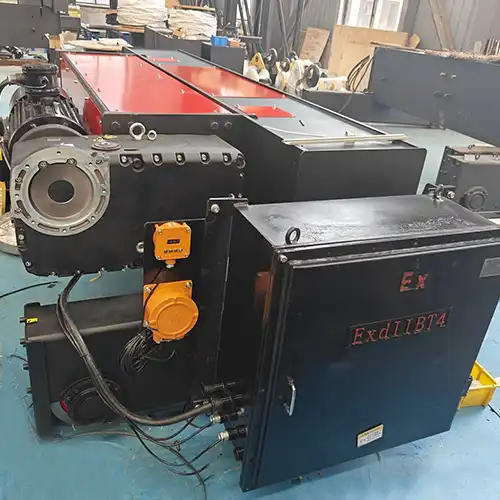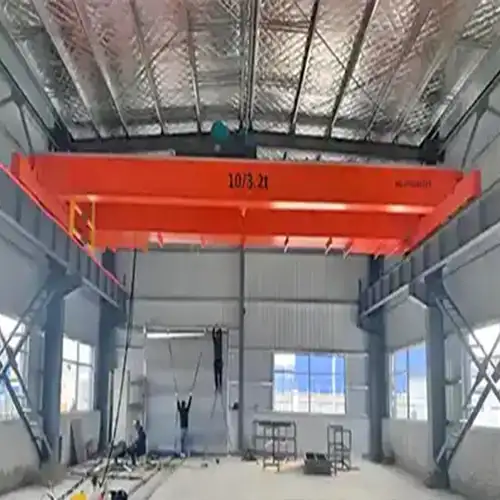Overhead Crane for Oil & Gas| 1& 2 Girder Crane, Explosion Proof Crane
Overhead crane for oil and gas industry, i.e., Single girder & double girder overhead crane, top running & underhung crane, explosion proof hoists and cranes
Category: Oil & Gas
Your Trusted Overhead Crane Manufacturer & Supplier
Overhead Crane for Oil & Gas,Custom Crane 1 Ton to 80 Ton
Single Girder & Double Girder Overhead Crane, Top Running & Underhung Crane, Explosion Proof Hoists and Cranes
Overhead crane for oil and gas industry, i.e., Single girder & double girder overhead crane, top running & underhung crane, explosion proof hoists and cranes.
Enhancing Efficiency in the Oil and Gas Industry with Overhead Cranes
In the world of industrial operations, where heavy equipment and materials play a pivotal role, the significance of efficient material handling cannot be overstated. Enter overhead cranes – engineering marvels that have revolutionized the way industries operate, especially in sectors as critical as oil and gas. In this blog, we delve into the very heart of industrial efficiency, exploring the introduction and importance of overhead cranes in the oil and gas sector.
Overhead cranes, often referred to as bridge cranes or suspended cranes, are versatile machines designed to lift, transport, and position heavy loads with precision and ease. Their unique structure, featuring a horizontal beam (bridge) that moves along elevated runways, allows them to handle substantial loads that human labor alone could never manage. Whether it's the extraction of crude oil, the transportation of equipment within refineries, or the loading and unloading of vessels, overhead cranes are indispensable tools in industries where efficiency and safety are paramount.
The core purpose of overhead cranes lies in their ability to optimize material handling processes, drastically reducing manual effort and expediting operations. These cranes excel in scenarios where heavy equipment, machinery, or materials need to be moved across distances, lifted to significant heights, or positioned with precision that manual labor cannot achieve. From fabrication shops to warehouses, from construction sites to manufacturing plants, overhead cranes have proven their worth across a wide spectrum of industries.
Importance in the Oil and Gas Sector:
Within the oil and gas sector, the demand for efficient material handling is particularly pronounced. The nature of oil and gas operations involves handling massive equipment, hazardous materials, and intricate components. This is where overhead cranes shine brightest. In the oil and gas industry, efficiency isn't just about saving time – it's about ensuring the safety of personnel, protecting valuable assets, and maintaining the integrity of critical equipment.
Efficiency Redefined:
Imagine the intricate operations on an offshore platform, where every movement of equipment matters. Overhead cranes are employed to transport heavy machinery, install vital components, and facilitate maintenance tasks. Their precision control and adaptability to confined spaces ensure that operations run smoothly even in challenging environments. In refineries, these cranes handle enormous vessels and components during maintenance, minimizing downtime and optimizing production.
Safety Amplified:
The oil and gas industry operates in hazardous environments where safety is non-negotiable. Overhead cranes with explosion-proof components and corrosion-resistant features are tailored to meet these challenges. They operate in areas where flammable gases are present, ensuring that operations continue with minimal risk of accidents.
In summary, overhead cranes are far more than mere machines; they are the backbone of efficiency and safety in industrial operations. In the oil and gas sector, their role is pivotal, ensuring that operations run seamlessly, personnel are safeguarded, and valuable equipment is handled with care. As technology advances, we can only anticipate further innovations in the field of material handling, reinforcing the indispensability of overhead cranes in driving industrial progress.
In the complex world of oil and gas, where every second counts, overhead cranes stand tall as the unsung heroes of efficiency – a testament to human ingenuity and engineering excellence.
Navigating the Sky: Exploring the Types of Overhead Cranes in the Oil and Gas Industry
The oil and gas industry is a complex and dynamic domain, where efficiency, safety, and precision are of paramount importance. Amidst this intricate landscape, a group of mechanical marvels known as overhead cranes play a vital role in ensuring operations run seamlessly. In this blog, we embark on a journey to understand the various types of overhead cranes used in the oil and gas industry, exploring their functions, advantages, and applications.
The Versatility of Overhead Cranes:
Overhead cranes, also called bridge cranes or suspended cranes, are a diverse range of heavy-duty lifting machines characterized by their unique structure. These cranes consist of a horizontal beam (bridge) that travels along elevated runways, allowing them to efficiently lift, transport, and position heavy loads with precision. In the oil and gas sector, where enormous equipment, hazardous materials, and intricate components are the norm, choosing the right type of overhead crane can make all the difference.
Overhead cranes play a crucial role in the oil and gas industry due to the nature of the work involved, which often includes heavy lifting, transporting, and positioning of materials and equipment. These cranes are essential for various tasks such as assembling rigs, moving heavy machinery, transporting pipes, and aiding in maintenance and repair work within refineries, drilling sites, and production facilities.
Types of Overhead Cranes Used in the Oil and Gas Industry:
Bridge Crane:
Bridge Cranes: Bridge cranes are commonly used in the oil and gas sector due to their versatility and ability to cover large areas. They consist of parallel runways with a traveling bridge spanning the gap. They can be top running (supported from the building structure) or underhung (suspended from the roof structure). These cranes can handle heavy loads and provide precise movement along both axes.
Features & Benefits: Bridge cranes offer high load capacities, smooth and precise movement, and can cover a wide area, enabling efficient material handling. They are often used for assembling equipment, moving heavy machinery, and general material handling within the industry.
Applications:- Assembling heavy machinery and equipment.Transporting large and heavy materials.General material handling within refineries and drilling sites.Maintenance and repair work within facilities.Assembly operations for smaller components.Handling smaller loads in specific areas within refineries and drilling sites.
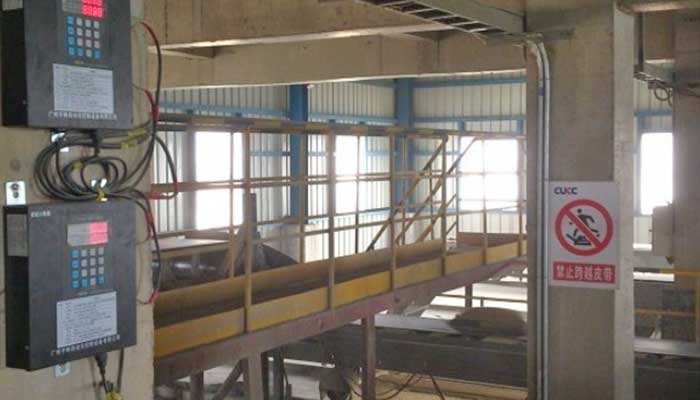
The top running crane with single girder or double girder design is a workhorse designed to carry heavy loads while maintaining impeccable precision. It operates on elevated runways, offering remarkable stability and strength. With high lifting capacities and precise controls, top running cranes are adept at handling the weighty equipment found in drilling, extraction, and refining processes. Whether it's moving wellhead components, lifting massive machinery, or transporting materials within a refinery, top running cranes stand as stalwart allies.
- Capacity: Top running bridge cranes in the oil and gas industry can have varying capacities, often ranging from a few tons to several hundred tons, depending on the specific requirements of the facility.
- Functions: These cranes are capable of traversing along the top of the runway system installed on the overhead structure. They provide efficient coverage of the workspace and are suitable for heavy lifting and material handling tasks.
- Load Handling: Top running cranes handle a wide range of loads, including equipment, machinery, pipes, components, and materials required in drilling, refining, and maintenance operations.
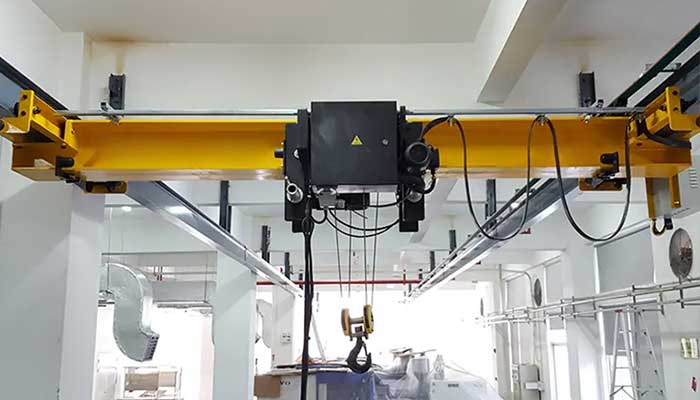
Under running cranes, available in single girder and double girder configurations, exhibit exceptional adaptability in space-constrained environments. Their unique design allows them to operate beneath the supporting structure, optimizing headroom and facilitating efficient material handling. These explosion proof undehrung bridge cranes find their niche in tasks that demand precise lifting and positioning within confined spaces, making them invaluable for maintenance and indoor operations.
- Capacity: Underhung cranes typically have lower load capacities compared to top running cranes and are commonly used for lighter loads in the oil and gas industry.
- Functions: Mounted below the overhead runway system, these cranes provide versatile and precise handling within the designated area. They're suitable for tasks requiring precise positioning and control.
- Load Handling: Underhung cranes handle lighter loads such as smaller equipment, tools, and components within confined spaces or specific work areas.
Gantry Cranes:
Gantry cranes are similar to bridge cranes but are supported by legs that run on wheels or along tracks on the ground. These cranes are ideal for outdoor applications, where there might not be overhead support structures.
Features & Benefits: Gantry cranes are versatile and can be easily moved within a facility or used in outdoor areas. They provide excellent mobility and lifting capabilities, making them suitable for loading and unloading heavy materials, transporting equipment, and supporting construction activities in oil and gas environments.
Applications:- Material handling in outdoor oil and gas facilities.Loading/unloading heavy materials in various environments.Supporting construction tasks within refineries and drilling sites.
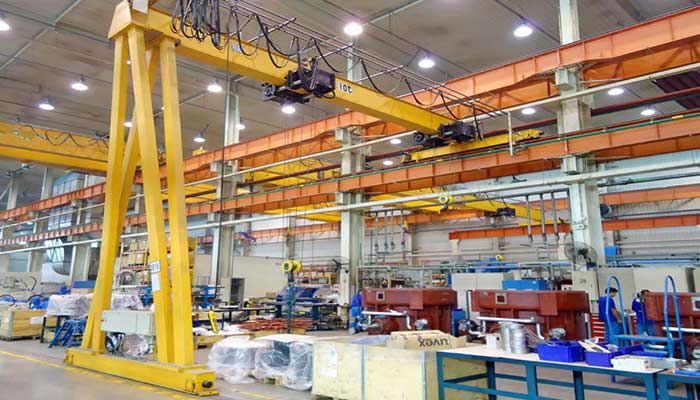
- Capacity: Semi gantry cranes are designed to handle moderate to heavy loads and are capable of lifting several tons.
- Functions: These cranes combine features of both gantry and overhead bridge cranes, with one end supported on a runway beam and the other supported by legs or wheels. They provide lateral movement for flexible material handling.
- Load Handling: Semi gantry cranes handle various loads within a specific area, offering flexibility and adaptability for different tasks in oil and gas facilities.
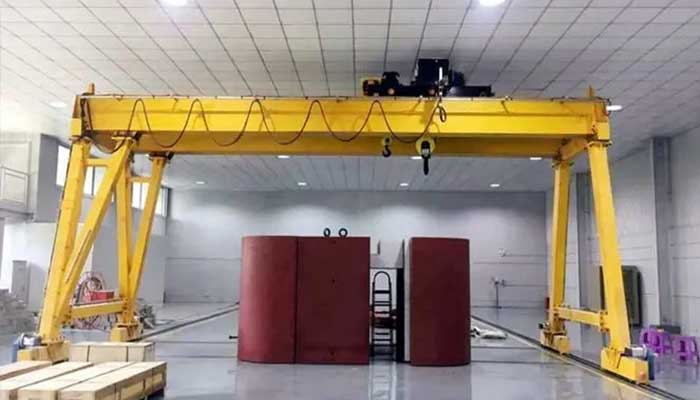
- Capacity: Full gantry cranes have substantial load capacities and are capable of lifting heavy loads, often ranging from tens to several hundred tons.
- Functions: Supported by legs running on wheels or tracks, full gantry cranes offer mobility and versatility. They're suitable for outdoor applications and can cover a larger area than semi gantry cranes.
- Load Handling: Full gantry cranes handle heavy equipment, large machinery, and materials both indoors and outdoors within oil and gas facilities, including loading/unloading in outdoor environments.
Jib cranes have a horizontal jib or boom that supports a moveable hoist. They can be wall-mounted or freestanding, allowing for rotation or lateral movement to reach different areas within a limited workspace.
Features & Benefits: Jib cranes are useful for localized lifting and positioning tasks. They are efficient for maintenance work, assembly operations, and handling smaller loads in specific areas where a larger crane might not be suitable.
Applications of Jib Crane in Oil and Gas Indutry: Maintenance and Repairs: Jib cranes are beneficial for maintenance tasks, offering precise and localized lifting capabilities in confined spaces.
Overall, the choice of overhead crane in the oil and gas industry depends on the specific requirements of the operation, space availability, lifting capacity, and mobility needed within the facility. Each type serves its purpose in facilitating efficient and safe material handling and operation in this industry.
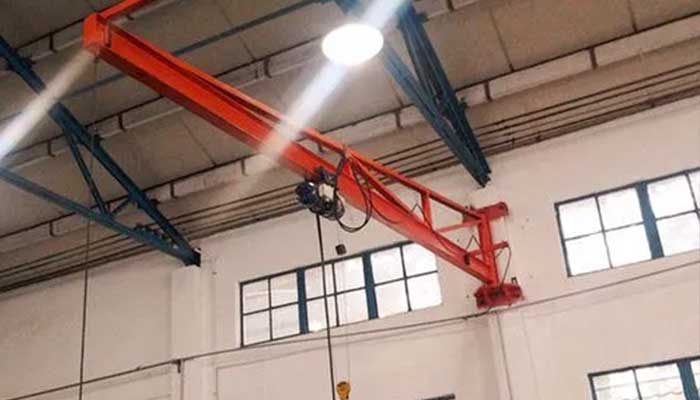
- Capacity: Wall-mounted jib cranes can handle lighter to moderate loads, typically ranging from a few hundred kilograms to a few tons.
- Functions: Wall jib cranes are fixed to walls or columns and provide localized lifting and precise positioning of loads within a limited radius. They offer a rotational movement for material handling.
- Load Handling: Used for handling smaller loads in specific areas within oil and gas facilities, supporting maintenance and assembly tasks.
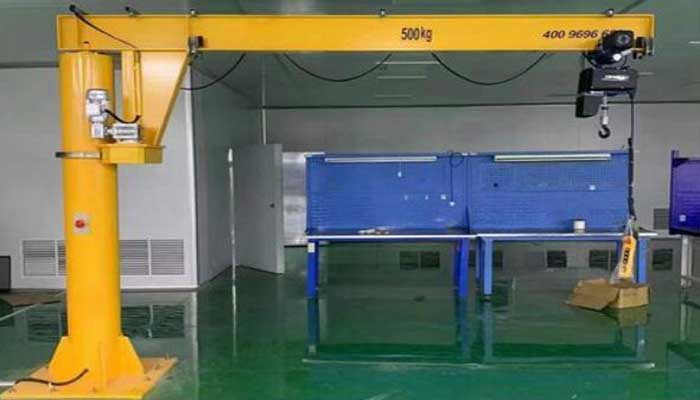
- Capacity: Floor-mounted jib cranes have similar load capacities to wall-mounted versions, usually handling lighter to moderate loads.
- Functions: These cranes are mounted on the floor, offering localized lifting and rotation to handle materials or equipment within a confined space.
- Load Handling: Floor jib cranes handle smaller loads and assist in assembly, maintenance, or material handling tasks within limited areas of oil and gas facilities.
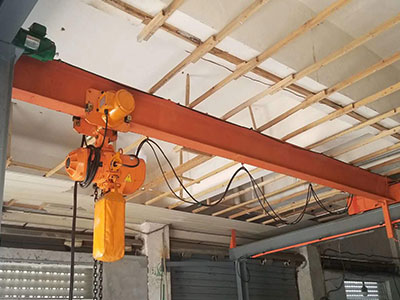
Features:
Utilizes an electric chain for lifting loads.
Compact and lightweight design.
Offers single or dual lifting speeds.
Easy to install and operate.
Benefits:
Versatile and suitable for various lifting applications.
Easy and quick installation.
Precise load positioning and control.
Enhanced safety features.
Applications:
Ideal for lighter lifting tasks within confined spaces.
Suitable for maintenance and assembly work.
Used in conjunction with different types of cranes or as standalone units.
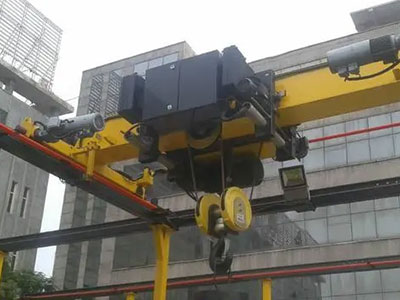
Features:
Uses an electrically driven drum with wire rope for lifting.
Higher lifting capacities compared to chain hoists.
Smooth and precise lifting operations.
Variable lifting speeds available.
Benefits:
Suitable for heavier lifting applications.
Precise load control and positioning.
Durable and long-lasting performance.
Versatile and adaptable to various work environments.
Applications:
Lifting heavier loads within oil and gas facilities.
Rigging operations and heavy equipment handling.
Critical lifting tasks requiring precise control and reliability.
Each type of crane and hoist offers specific advantages, making them suitable for various tasks and environments within the oil and gas industry. The choice depends on factors such as load requirements, workspace limitations, and the nature of the lifting operation.
Choosing the Right Crane:
Selecting the appropriate type of overhead crane is a decision that hinges on operational requirements, space limitations, and load capacities. Each crane type brings its unique set of advantages, and understanding their capabilities empowers the oil and gas industry to optimize its material handling processes.
As the oil and gas industry evolves, the role of overhead cranes remains pivotal. These engineering marvels enable the sector to navigate complex operations with finesse, ensuring that heavy equipment is handled with care, safety is upheld, and efficiency is paramount. Whether it's the towering top running crane or the precise jib crane, these machines exemplify innovation and ingenuity, reflecting the very essence of progress in the oil and gas industry.
Meeting the Challenge: Key Requirements for Overhead Cranes in the Oil and Gas Industry
In the oil and gas industry, where precision, safety, and adaptability are paramount, the choice of equipment plays a pivotal role. Among the many tools that enhance operational efficiency, overhead cranes stand tall as silent yet indispensable workhorses. However, the demanding nature of this sector necessitates that these cranes meet a set of stringent requirements. In this article, we delve into the key prerequisites that overhead cranes must satisfy to seamlessly operate within the challenging realm of oil and gas.
Safety First:
Safety considerations are the bedrock of any equipment used in the oil and gas industry. Overhead cranes are no exception. These machines must adhere to internationally recognized safety standards and certifications. Organizations like OSHA (Occupational Safety and Health Administration) ensure that cranes are designed, constructed, and operated with the utmost regard for personnel safety. Compliance with regulations such as ATEX (Atmosphères Explosibles) and API (American Petroleum Institute) is crucial, especially in areas with potentially explosive atmospheres.
Load Capacity and Precision:
The oil and gas industry deals with a vast range of equipment, machinery, and materials, all varying in weight and size. Overhead cranes must be engineered to handle these diverse loads while maintaining precise positioning. Whether it's lifting a massive wellhead component or positioning delicate equipment, cranes should be designed with load capacities that align with the industry's demands. Additionally, precision control systems play a pivotal role in ensuring that heavy loads can be maneuvered with the accuracy required for seamless operations.
Adaptability to Hazardous Environments:
The oil and gas sector often involves operating in hazardous environments where the presence of flammable gases and corrosive materials is commonplace. Overhead cranes utilized in such settings must be equipped with specialized features. Explosion-proof components, meticulously designed to prevent the ignition of flammable substances, are an imperative. Corrosion-resistant materials ensure the longevity of cranes operating in offshore environments or those exposed to corrosive chemicals.
Tailored Features for Efficiency:
Overhead cranes must not only meet the baseline requirements but also exhibit a degree of customization. The oil and gas industry thrives on efficiency, and cranes that are tailor-made for specific tasks can significantly boost productivity. Whether it's an offshore platform with limited space or a refinery with strict safety regulations, the ability of cranes to adapt to these unique challenges is of paramount importance.
In the oil and gas industry, overhead cranes are more than just mechanical equipment; they are the backbone of operations. They must seamlessly integrate into the intricate web of tasks, ensuring safety, efficiency, and reliability. By meeting the key requirements – from adhering to safety standards to adapting to hazardous conditions – overhead cranes become a driving force in elevating the oil and gas industry to new heights of excellence. As technology advances, these cranes will continue to evolve, meeting the ever-evolving challenges of this critical sector.
Special Overhead Cranes for Oil and Gas Industry
The oil and gas industry often requires specialized overhead cranes designed to meet the unique challenges and demands of the sector. Some specialized overhead cranes commonly used in the oil and gas industry include:
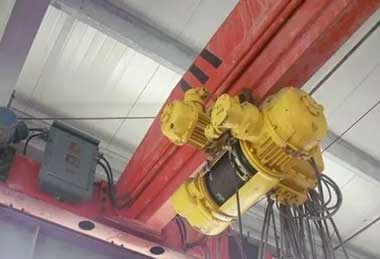
In hazardous environments where flammable gases or vapors are present, explosion-proof cranes are crucial. These cranes are designed with specialized features to prevent sparks or ignition sources that could cause explosions. They often include sealed electrical components, protected wiring, and enclosures to mitigate the risk of fire or explosion.
Features:
- Sealed electrical components and wiring to prevent sparks.
- Explosion-proof enclosures to contain potential ignition sources.
- Corrosion-resistant materials to withstand harsh environments.
- Compliance with strict safety standards and certifications.
Functions:
- Safe operation in hazardous areas with flammable gases or vapors.
- Minimization of explosion risks during lifting operations.
- Reliable performance in potentially explosive environments.
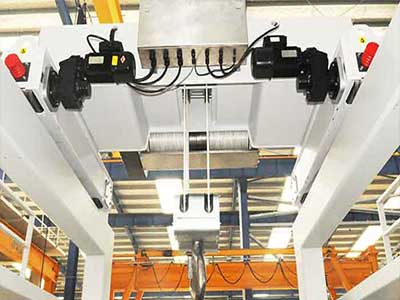
Given the corrosive nature of some oil and gas environments (such as offshore rigs or refineries), cranes need to withstand exposure to saltwater, chemicals, and harsh weather conditions. Corrosion-resistant materials, protective coatings, and stainless steel components are used to enhance durability and longevity in such settings.
Features:
- Use of stainless steel or corrosion-resistant materials.
- Protective coatings or finishes to prevent corrosion.
- Sealed components and electrical systems for added protection.
Functions:
- Endurance in corrosive environments like offshore rigs or refineries.
- Longevity and durability despite exposure to harsh conditions.
- Reduced maintenance needs due to corrosion-resistant construction.
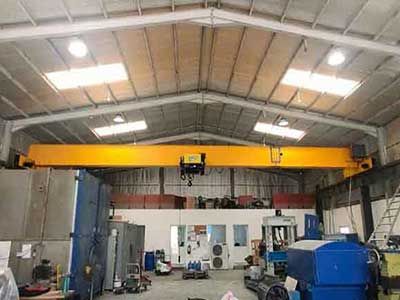
Top Running Cranes with Anti-Sway Technology:
Top running bridge cranes equipped with anti-sway technology are used for precise load control. These systems incorporate sensors and controls to minimize load swing, enhancing safety and efficiency, particularly when handling sensitive or fragile equipment.
Features:
- High load capacities and precise lifting capabilities.
- Anti-sway technology using sensors and control systems.
- Robust structures for stability during operations.
Functions:
- Minimization of load swing for safe and accurate lifting.
- Enhanced control and stability when handling delicate or heavy loads.
- Increased efficiency and reduced downtime during lifting operations.
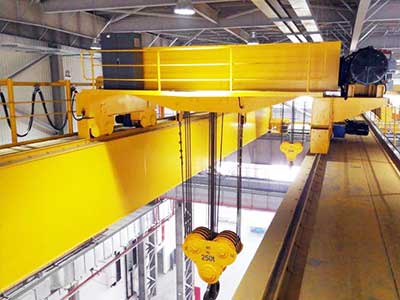
Heavy-Duty High-Capacity Cranes:
The oil and gas industry often deals with exceptionally heavy loads, requiring cranes with high lifting capacities. Custom-built or modified heavy-duty cranes capable of handling massive weights efficiently are essential for tasks like lifting drilling equipment, large pipes, or heavy machinery.
Features:
- Robust construction with reinforced components.
- High load capacities tailored for heavy lifting tasks.
- Reliable and durable design for continuous heavy-duty use.
Functions:
- Handling of exceptionally heavy loads common in the oil and gas industry.
- Efficient and safe lifting of drilling equipment, machinery, or large components.
- Support for high-capacity lifting operations without compromising safety.
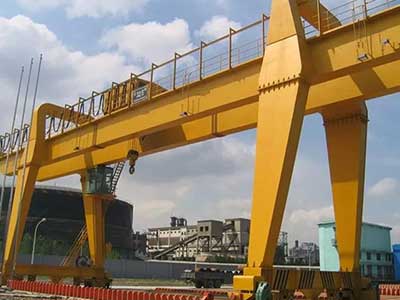
Gantry Cranes for Offshore Applications:
Offshore operations demand cranes that can withstand harsh marine conditions. Gantry cranes designed for offshore use have special features like marine-grade coatings, corrosion-resistant materials, and mechanisms to handle loads in open sea environments.
Features:
- Marine-grade coatings and materials for corrosion resistance.
- Specialized components designed to withstand marine environments.
- Weatherproofing and protection against harsh offshore conditions.
Functions:
- Adaptability to offshore settings for cargo handling or maintenance tasks.
- Safe and reliable lifting in open sea environments.
- Durability and resilience against saltwater exposure and adverse weather.
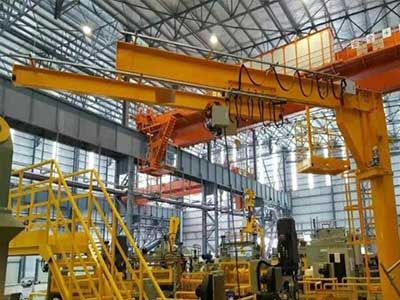
These cranes have a telescoping boom that provides additional reach and flexibility, making them suitable for tasks requiring extended reach, such as assembly or maintenance on oil rigs or platforms.
Features:
- Extendable booms for increased reach and flexibility.
- Enhanced mobility and maneuverability due to telescoping design.
- Various load handling attachments for versatility.
Functions:
- Reaching distant or difficult-to-access areas for lifting operations.
- Handling tasks requiring extended reach, such as assembly or maintenance on rigs or platforms.
- Versatile functionality in various working conditions.
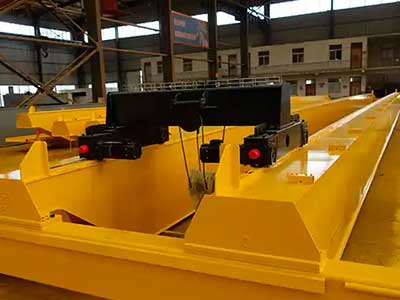
Automated crane or Remote-Controlled Cranes:
Incorporating automation and remote control features in European style cranes allows for precise and efficient operations, reducing the need for direct human intervention in hazardous or hard-to-reach areas.
Features:
- Integration of automation technology for remote operation.
- Control systems for precise and efficient crane movements.
- Safety features like collision avoidance systems.
Functions:
- Remote operation for increased safety in hazardous or hard-to-reach areas.
- Automation for optimized efficiency and reduced human intervention.
- Enhanced precision and control during lifting and material handling tasks.
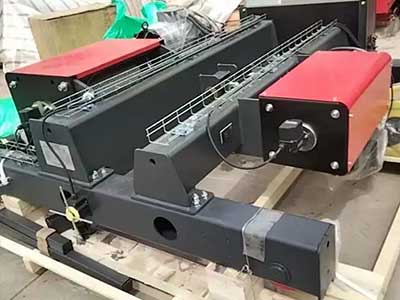
High-Speed Hoists or Trolley Movements:
In situations where speed is crucial for efficient material handling, cranes equipped with high-speed hoists or trolleys are used to enhance productivity and reduce operational downtime.
Features:
- High-speed hoists or trolleys for rapid lifting or movement.
- Enhanced motor performance for increased speed.
- Precision control and safety mechanisms for high-speed operations.
Functions:
- Accelerated material handling for improved productivity.
- Reduction of downtime by speeding up lifting or transport operations.
- Maintaining safety standards and precise control despite increased speed.
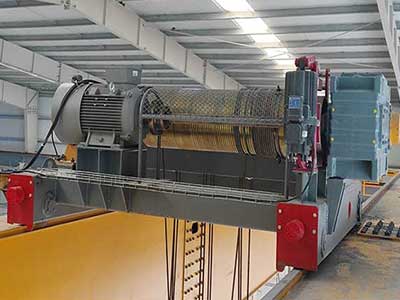
Customized Special-Purpose Cranes:
Some oil and gas facilities require cranes specifically tailored for unique tasks or layouts within the facility. These may include special-purpose jib cranes, customized bridge cranes, or gantry cranes adapted to fit specific operational needs.
Features:
- Tailored design to meet specific operational needs.
- Customized configurations or attachments for unique tasks.
- Adaptation to specific layouts or requirements within facilities.
Functions:
- Addressing unique challenges or tasks within the oil and gas industry.
- Optimizing efficiency by matching the crane's capabilities to specific operations.
- Providing specialized solutions for handling equipment or materials in the facility.
These specialized overhead cranes cater to the specific challenges and safety requirements present in the oil and gas industry. Their design, materials, and features are tailored to ensure efficient and safe handling of heavy loads, withstand harsh environmental conditions, and comply with industry regulations.
Powering Efficiency: Overhead Cranes in Various Oil and Gas Operations
The oil and gas industry is a symphony of intricate processes, where each stage demands precision, safety, and efficiency. In this intricate dance, overhead cranes emerge as the unsung heroes, orchestrating the movement of heavy loads and materials. Let's explore how these mechanical marvels play a vital role in various oil and gas procedures, from exploration and drilling to the final stages of processing and distribution.
Exploration and Drilling:
In the realm of exploration and drilling, where the search for energy resources begins, overhead cranes prove their mettle. Here, the towering top running cranes shine. Their high lifting capacities and precision control allow them to handle the weighty components required for drilling operations. From transporting drilling equipment to positioning wellhead components, these cranes streamline the process, ensuring a firm foundation for energy extraction. Exploration and drilling operations require cranes for handling heavy equipment, positioning wellhead components, and transporting drilling machinery.
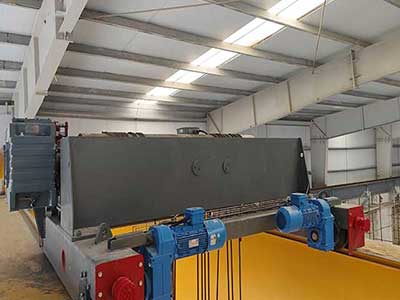
Typical Crane Used: Top Running Bridge Cranes.
Crane Design & Configurations:
- Top Running Bridge Cranes: High lifting capacities, precision control, and suitable for heavy drilling components.
- Configurations: Spanning the exploration and drilling areas for efficient handling.
Main Functions & Typical Features:
- Heavy Load Handling: Capable of lifting and positioning drilling equipment.
- Precision Control: Ensures accurate and safe handling of critical components.
- Adaptability: Able to accommodate varying drilling operation needs.
Production and Extraction:
As oil and gas are brought to the surface, the role of overhead cranes transitions from exploration to extraction. The robust top running cranes continue to dominate, facilitating the smooth extraction of crude oil or natural gas. These cranes are tailored to handle the demands of lifting and transporting heavy machinery, safeguarding personnel and assets throughout the process. During production and extraction phases, cranes assist in handling machinery, transporting equipment, and positioning well components.
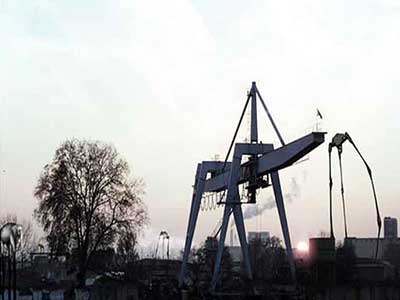
Typical Crane Used: Gantry Cranes, Pedestal Cranes.
Crane Design & Configurations:
- Gantry Cranes: Mobile, adaptable for outdoor production sites.
- Pedestal Cranes: Fixed on platforms for handling machinery.
Main Functions & Typical Features:
- Equipment Handling: Moving machinery, well components, and tools.
- Adaptability: Gantry cranes suitable for different extraction environments.
Refining and Processing:
Once extracted, the valuable resources undergo a refining and processing journey. Here, overhead cranes transform into versatile gantry cranes. Their ability to traverse indoor and outdoor spaces makes them ideal for tasks like loading and unloading materials, positioning equipment for maintenance, and facilitating the intricate processes that refine raw materials into valuable products. Refineries and processing plants require cranes for handling heavy equipment and moving refinery components.
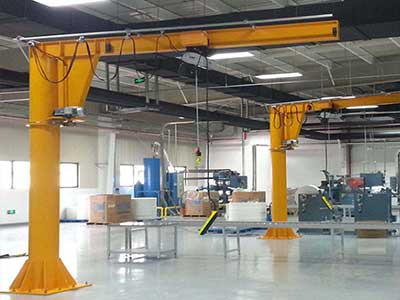
Typical Crane Used: Bridge Cranes, Jib Cranes.
- Crane Design & Configurations:
- Bridge Cranes: Installed within refinery structures for material handling.
- Jib Cranes: Localized lifting within refinery areas.
Main Functions & Typical Features:
- Material Handling: Transporting heavy refinery equipment.
- Precise Lifting: Jib cranes for precise, confined space lifting tasks.
Transportation and Loading/Unloading:
In the realm of transportation and loading/unloading, the importance of efficient material handling cannot be overstated. Overhead cranes come to the forefront, ensuring the seamless movement of heavy loads from one point to another. From loading vessels with valuable cargo to unloading raw materials for refining, these cranes enhance operational efficiency at every stage. Cranes are used for loading/unloading cargo onto vessels and transporting equipment within transportation hubs.
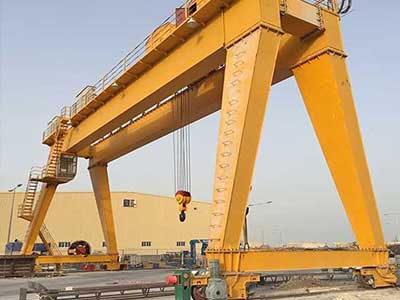
Typical Crane Used: Port Cranes, Gantry Cranes.
- Crane Design & Configurations:
- Port Cranes: Specifically designed for loading/unloading cargo from ships.
- Gantry Cranes: Adapted for outdoor cargo handling.
Main Functions & Typical Features:
- Cargo Handling: Lifting and moving cargo efficiently.
- Versatility: Gantry cranes adaptable for various transportation needs.
Maintenance and Repair:
In a sector as critical as oil and gas, equipment maintenance and repair are of paramount importance. Here, jib cranes take center stage. Their precise lifting and positioning capabilities assist maintenance personnel in handling delicate components, replacing parts, and conducting inspections – all while adhering to stringent safety protocols. Cranes support maintenance work by lifting and positioning machinery, facilitating repair and replacement tasks.
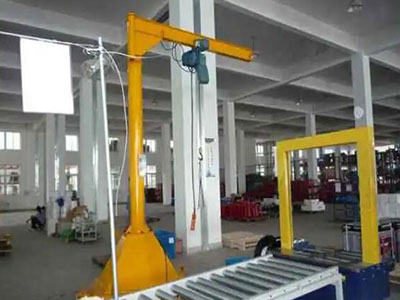
Typical Crane Used: Jib Cranes, Bridge Cranes.
- Crane Design & Configurations:
- Bridge Cranes: Installed within maintenance areas for versatile lifting.
- Jib Cranes: Wall-mounted or freestanding for localized maintenance tasks.
Main Functions & Typical Features:
- Precision Control: Facilitates accurate maintenance operations.
- Accessibility: Jib cranes for accessing specific machinery.
Offshore Platforms:
Offshore platforms, with their unique challenges and environments, demand specialized solutions. Top running cranes equipped with corrosion-resistant materials and explosion-proof components come into play. These cranes are essential for tasks ranging from equipment installation and maintenance to ensuring the safety of personnel working in these challenging settings. Offshore platforms require cranes for construction, equipment handling, and cargo operations.

Typical Crane Used: Pedestal Cranes, Gantry Cranes.
Crane Design & Configurations:
- Pedestal Cranes: Fixed on platforms for construction tasks.
- Gantry Cranes: Adapted versions for offshore use.
Main Functions & Typical Features:
- Heavy Lifting: Lifting and positioning platform components.
- Sturdiness: Designed for offshore environmental conditions.
Storage Yards and Warehouses:
In storage yards and warehouses, the expansive reach of gantry cranes proves invaluable. These cranes efficiently load and unload materials, stack heavy containers, and facilitate the movement of resources within confined spaces, optimizing storage capacity and enhancing retrieval processes. Cranes assist in handling and moving materials within storage yards and warehouses.
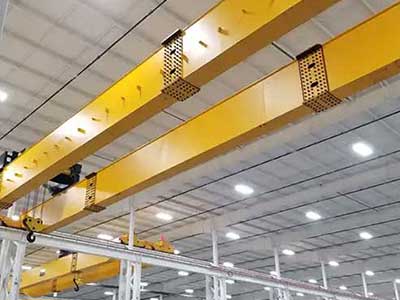
Typical Crane Used: Overhead Bridge Cranes, Gantry Cranes.
Crane Design & Configurations:
- Overhead Bridge Cranes: Installed within warehouse structures.
- Gantry Cranes: Mobile for outdoor storage yards.
Main Functions & Typical Features:
- Material Handling: Efficient movement of materials within storage areas.
- Adaptability: Gantry cranes for outdoor storage yard requirements.
Pipeline Installation:
In the intricate network of pipelines, precision is crucial. Top running cranes equipped with precision controls ensure the accurate placement of pipeline sections. Their ability to lift and position heavy pipes with minimal disruption streamlines installation processes, reducing downtime and ensuring pipeline integrity. Cranes support the installation of pipelines by lifting and positioning pipe sections and equipment.
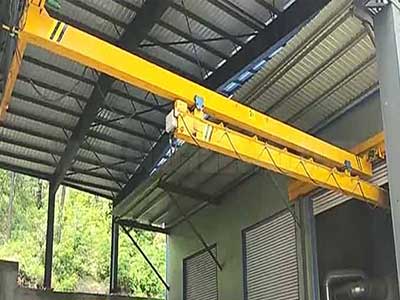
Typical Crane Used: Siding Cantilever Cranes,
Crane Design & Configurations:
- Side Boom Cranes: Specialized for pipeline installation tasks.
- Crawler Cranes: Mobile and adaptable for pipeline construction.
Main Functions & Typical Features:
- Pipeline Handling: Lifting and positioning pipeline sections.
- Mobility: Crawler cranes for navigating varied terrains.
Liquefied Natural Gas (LNG) Terminals:
LNG terminals, with their focus on handling liquefied natural gas, rely on gantry cranes to ensure safe and efficient operations. These cranes assist in loading and unloading LNG containers, positioning storage tanks, and facilitating maintenance tasks within the terminal. LNG terminals require cranes for cargo handling, equipment installation, and maintenance.

Typical Crane Used: Gantry Cranes, Port Cranes.
Crane Design & Configurations:
- Gantry Cranes: Adapted versions for LNG terminal cargo operations.
- Port Cranes: Specifically designed for loading/unloading LNG cargo.
Main Functions & Typical Features:
- Cargo Handling: Lifting and moving LNG cargo efficiently.
- Specialized Design: Port cranes tailored for LNG terminal requirements.
From the early stages of exploration to the final steps of distribution, overhead cranes play an instrumental role in the oil and gas industry. Tailored to meet the demands of each stage, these cranes optimize efficiency, enhance safety, and streamline the complex processes that power our modern world. As technology advances, overhead cranes will continue to evolve, standing as a testament to human ingenuity and engineering excellence in the oil and gas sector.
Precision in Action: Tailored Features of Overhead Cranes for the Oil and Gas Industry
The oil and gas industry is a realm where challenges and demands vary as vastly as the terrains explored and resources extracted. Within this intricate landscape, the versatility of overhead cranes shines even brighter when equipped with tailored features. These features are more than just refinements – they are essential adaptations that ensure cranes seamlessly integrate into the unique demands of each application. In this article, we delve into the tailored features that elevate overhead cranes for specific tasks within the oil and gas sector.
Corrosion-Resistant Materials for Harsh Environments:
Offshore platforms and chemical processing environments subject equipment to corrosive forces. In response, overhead cranes are crafted with materials that resist corrosion, ensuring their longevity and reliability even in the harshest conditions. From specialized coatings to stainless steel components, these features ensure that cranes maintain their integrity in the face of saltwater, chemicals, and adverse weather.
Explosion-Proof Components for Safety:
In areas where flammable gases or combustible dust pose a threat, explosion-proof components become a non-negotiable requirement. Overhead cranes equipped with explosion-proof electrical systems and enclosures ensure that the risk of ignition is minimized. This feature safeguards personnel and assets, providing peace of mind in hazardous environments such as refineries and petrochemical plants.
Precision Control Systems for Accuracy:
The precision of movement required in the oil and gas sector leaves no room for error. Overhead cranes designed for accuracy are equipped with sophisticated control systems that allow operators to position heavy loads with pinpoint precision. This level of control is vital for tasks such as assembling intricate components or aligning equipment during maintenance procedures.
Ergonomic Designs for Operator Comfort:
The human-machine interaction is a critical aspect of any operation. Overhead cranes designed with ergonomic features prioritize operator comfort and safety. Adjustable controls, operator-friendly interfaces, and anti-fatigue measures contribute to minimizing operator strain, enhancing concentration, and optimizing overall efficiency.
Adaptability to Confined Spaces and Outdoor Environments:
Oil and gas operations often take place in confined spaces or outdoor environments where every inch matters. Overhead cranes crafted for such scenarios are compact and adaptable, enabling them to operate in spaces where traditional cranes might struggle. Their ability to navigate tight spaces or withstand the elements ensures seamless operations in complex surroundings.
In the oil and gas industry, where precision, safety, and efficiency are non-negotiable, tailored features transform overhead cranes into specialized tools. These features address the unique challenges presented by each application, from offshore platforms battling the elements to refineries navigating hazardous environments. As overhead cranes evolve alongside technology and industry demands, the tailored features that enhance their capabilities will continue to play a pivotal role in shaping the future of material handling within the oil and gas sector.
Typical Applications of Overhead Cranes in Oil and Gas Industry
Rig Construction and Assembly:
Overview: Overhead cranes play a vital role in constructing and assembling drilling rigs, lifting and positioning heavy components like derricks, platforms, drilling equipment, and machinery.
Typical Crane Used: Bridge Cranes and Gantry Cranes.
Crane Design & Configurations:
Bridge Cranes: Typically top-running, spanning the width of the rig assembly area.
Gantry Cranes: Mobile with legs on wheels or tracks, adaptable for outdoor rig assembly.
Main Functions & Typical Features:
High Load Capacity: Able to lift and position heavy rig components.
Wide Span Coverage: Capable of covering the entire rig assembly area.
Precise Movement: Ensures accurate positioning of components.
Adaptability: Gantry cranes' mobility facilitates use in varying rig construction environments.
Material Handling in Refineries:
Overview: Cranes in refineries handle large equipment like heat exchangers, pressure vessels, reactors, and distillation columns.
Typical Crane Used: Bridge Cranes, Gantry Cranes, and Jib Cranes.
Crane Design & Configurations:
Bridge Cranes: Installed within refinery structures, covering designated work areas.
Gantry Cranes: Used in outdoor refinery spaces for heavy material handling.
Jib Cranes: Wall-mounted or freestanding for localized lifting in specific refinery areas.
Main Functions & Typical Features:
Heavy Load Handling: Capability to lift and move refinery equipment.
Versatility: Bridge and Gantry cranes for varied refinery environments.
Precise Positioning: Jib cranes for precise, localized lifting tasks.
Transporting Pipes and Tubing:
Overview: Cranes are used for loading, unloading, and positioning pipes and tubing used in drilling and oil extraction.
Typical Crane Used: Gantry Cranes, Jib Cranes.
Crane Design & Configurations:
Gantry Cranes: Mobility for outdoor pipe handling.
Jib Cranes: Precise and localized movement for pipe handling in specific areas.
Main Functions & Typical Features:
Efficient Transport: Gantry cranes for moving pipes within drilling sites.
Precise Handling: Jib cranes for careful positioning of pipes during assembly.
Maintenance and Repairs:
Overview: Overhead cranes assist in lifting and positioning machinery, engines, pumps, etc., for maintenance purposes.
Typical Crane Used: Jib Cranes, Bridge Cranes.
Crane Design & Configurations:
Bridge Cranes: Installed within maintenance areas for versatile lifting.
Jib Cranes: Wall-mounted or freestanding for localized maintenance tasks.
Main Functions & Typical Features:
Precision and Control: Both crane types offer precise movements for maintenance tasks.
Accessibility: Jib cranes' localized movement aids in accessing specific machinery.
Loading and Unloading Cargo:
Overview: Cranes on offshore platforms handle loading and unloading of cargo from supply vessels.
Typical Crane Used: Pedestal Cranes, Gantry Cranes.
Crane Design & Configurations:
Pedestal Cranes: Fixed on platforms for cargo handling.
Gantry Cranes: Adapted for use in offshore environments for cargo operations.
Main Functions & Typical Features:
Heavy Load Handling: Capable of handling heavy cargo.
Adaptability: Gantry cranes can be modified for offshore use.
Offshore Platform Construction:
Overview: Cranes assist in lifting and placing structural components and machinery onto offshore platforms.
Typical Crane Used: Pedestal Cranes, Gantry Cranes.
Crane Design & Configurations:
Pedestal Cranes: Fixed on platforms for construction tasks.
Gantry Cranes: Adapted versions for construction activities on platforms.
Main Functions & Typical Features:
Heavy Lifting: Ability to lift and position platform components and machinery.
Sturdiness: Designed to withstand offshore conditions.
Supporting Drilling Operations:
Overview: Cranes handle drilling tools, equipment, and wellhead components during installation and maintenance.
Typical Crane Used: Bridge Cranes, Gantry Cranes.
Crane Design & Configurations:
Bridge Cranes: Installed in drilling areas for equipment handling.
Gantry Cranes: Used in outdoor drilling environments.
Main Functions & Typical Features:
Equipment Handling: Capable of moving and positioning drilling tools and components.
Adaptability: Gantry cranes for use in varying drilling environments.
Handling Heavy Equipment:
Overview: Cranes assist in moving compressors, generators, turbines, and storage tanks within facilities.
Typical Crane Used: Bridge Cranes, Gantry Cranes.
Crane Design & Configurations:
Bridge Cranes: Installed within facilities for equipment handling.
Gantry Cranes: Adapted versions for indoor heavy equipment handling.
Main Functions & Typical Features:
Heavy Load Capacity: Ability to handle various heavy equipment within facilities.
Versatility: Suitable for different types of equipment movement.
Emergency Response and Rescue:
Overview: Cranes used in emergency situations for lifting and moving heavy objects or aiding in rescue efforts.
Typical Crane Used: Portable or Mobile Cranes, Jib Cranes.
Crane Design & Configurations:
Portable or Mobile Cranes: Easily transported to emergency sites.
Jib Cranes: Adapted for emergency lifting and rescue tasks.
Main Functions & Typical Features:
Mobility: Ability to quickly reach emergency locations.
Precision and Control: Jib cranes for controlled lifting in rescue scenarios.
Waste Management:
Overview: Cranes assist in handling and transporting waste materials generated during oil and gas production.
Typical Crane Used: Bridge Cranes, Gantry Cranes.
Crane Design & Configurations:
Bridge Cranes: Installed within waste management areas.
Gantry Cranes: Adapted versions for waste handling.
Main Functions & Typical Features:
Waste Handling: Capable of moving and transporting waste materials efficiently.
Durable Construction: Designed to withstand waste handling conditions.
These applications showcase the diverse roles that different types of overhead cranes play within the oil and gas industry, addressing specific needs in construction, maintenance, logistics, and emergency scenarios.
Elevating Excellence: Benefits of Overhead Cranes in the Oil and Gas Industry
In the dynamic world of the oil and gas industry, where precision and efficiency are the pillars of success, overhead cranes emerge as game-changers. These mechanical powerhouses not only handle heavy loads but also revolutionize the way tasks are executed. In this article, we delve into the multifaceted benefits that overhead cranes bring to the oil and gas sector, fostering increased efficiency, safety, and precision.
Increased Efficiency and Productivity:
Time is of the essence in the oil and gas industry, and overhead cranes are adept at transforming tasks that would otherwise be labor-intensive and time-consuming. By automating material handling, these cranes drastically reduce the time required to move heavy loads, increasing the overall efficiency of operations. Whether it's transporting equipment to an offshore platform or unloading raw materials for processing, overhead cranes ensure tasks are completed with remarkable speed.
Enhanced Safety for Heavy Lifting and Material Handling:
Safety is the bedrock of any industrial operation, and overhead cranes are designed with safety as a priority. Human intervention in lifting heavy equipment can pose risks to personnel and assets. Overhead cranes mitigate these risks by replacing manual lifting with controlled, mechanical operations. This not only safeguards the well-being of workers but also prevents potential damage to valuable equipment.
Precise Positioning and Movement:
In the intricate world of oil and gas, where components fit together like puzzle pieces, precision is key. Overhead cranes are equipped with advanced control systems that enable operators to position heavy loads with the utmost accuracy. Whether it's assembling intricate machinery or aligning components during maintenance, the precise positioning capabilities of these cranes eliminate guesswork and reduce the likelihood of errors.
Adaptability to Various Procedures and Environments:
The oil and gas industry is a tapestry of diverse procedures and operational environments, each with its own set of challenges. Overhead cranes, with their versatility, seamlessly adapt to this diversity. From the confined spaces of offshore platforms to the expansive yards of refineries, these cranes can be tailored to navigate various settings. Their adaptability ensures that regardless of the task or location, operations can proceed smoothly.
In an industry where every action carries significant weight, overhead cranes emerge as a revolution in material handling. Their ability to increase efficiency, bolster safety, and provide precise control transforms the landscape of oil and gas operations. As technology continues to advance, these cranes will evolve, further enhancing their benefits and revolutionizing the industry. From boosting productivity to safeguarding workers, overhead cranes stand as a testament to human ingenuity and innovation in the pursuit of excellence within the oil and gas sector.
Navigating Challenges, Defining Solutions: Overhead Cranes in the Face of Oil and Gas Industry Hurdles
In the realm of the oil and gas industry, where complexity and adversity are constants, the role of overhead cranes is magnified. These mechanical workhorses facilitate operations in the face of numerous challenges, ensuring seamless execution. In this article, we delve into the daunting hurdles that overhead cranes encounter within the oil and gas sector and the ingenious solutions that drive them forward.
Addressing Extreme Weather Conditions:
Offshore platforms and Arctic environments present a formidable challenge for any equipment. Overhead cranes, perched on the precipice of changeable seas and unforgiving climates, must withstand the relentless assault of the elements. The solution lies in engineering cranes with corrosion-resistant materials that can endure the corrosive effects of saltwater and frigid temperatures. These cranes are designed to resist the erosion caused by sea spray, salt, and the ceaseless gusts of wind, ensuring they remain reliable in even the harshest environments.
Meeting Stringent Safety Regulations and Compliance Standards:
The oil and gas industry has no room for compromise when it comes to safety. Overhead cranes must adhere to stringent safety regulations and compliance standards to safeguard personnel and assets. Solution-oriented design involves integrating advanced safety features, such as limit switches, emergency stop buttons, and anti-collision systems. These features empower operators to conduct their tasks with confidence, knowing that their actions are safeguarded by fail-safes and safety protocols.
Overcoming Space Constraints in Confined Areas:
Confined spaces are a hallmark of the oil and gas sector, from the tight quarters of offshore platforms to the intricate maze of pipelines. Here, overhead cranes must navigate limited spaces without compromising their functionality. The solution is compact and adaptable designs that optimize the use of available space. Jib cranes, for instance, are designed to excel in tight spots, allowing for precise lifting and positioning even in confined areas. These cranes ensure that operations can proceed unhindered despite spatial limitations.
In the tapestry of challenges that define the oil and gas industry, overhead cranes serve as an emblem of resilience and innovation. The solutions crafted to overcome extreme weather conditions, uphold safety standards, and thrive in confined spaces are a testament to human ingenuity. As the industry continues to evolve, overhead cranes will stand as a steadfast companion, adapting to adversity and navigating through challenges to ensure that oil and gas operations proceed without compromise.
Elevating Excellence: Overhead Cranes' Lasting Impact on the Oil and Gas Industry
In the vast canvas of the oil and gas industry, where operations are intricate and demands are high, overhead cranes emerge as steadfast companions, orchestrating the seamless movement of heavy loads and valuable materials. As we draw the curtains on this exploration of overhead cranes' role within this critical sector, let's revisit the significance they hold and the transformative impact of tailored features that cater to the industry's unique demands.
A Crucial Component of Efficiency:
The oil and gas industry, a realm where precision, safety, and speed are paramount, finds an able ally in overhead cranes. These mechanical wonders optimize material handling, increasing efficiency and reducing the time required to move heavy loads. From exploration to transportation, maintenance to distribution, overhead cranes elevate the efficiency of operations at every stage.
Safety Beyond Measure:
Safety is the foundation of any industrial operation, and overhead cranes uphold this principle with unwavering dedication. Replacing manual lifting with controlled mechanical processes, these cranes safeguard personnel and assets. Explosion-proof components, corrosion-resistant materials, and advanced safety features stand as testament to their commitment to creating safe working environments, even in the most challenging settings.
Precision Redefined:
In an industry where precision is non-negotiable, overhead cranes shine with their precise positioning capabilities. The ability to lift and maneuver heavy equipment with pinpoint accuracy ensures seamless assembly, maintenance, and transport of critical components. These cranes redefine precision, reducing the likelihood of errors and streamlining processes.
Tailored for Triumph:
Perhaps the crowning glory of overhead cranes within the oil and gas sector lies in their ability to be tailored. From corrosion-resistant coatings that withstand harsh offshore conditions to explosion-proof components that defy hazardous environments, tailored features are the driving force that allows these cranes to excel in diverse applications. They are the embodiment of versatility, adapting seamlessly to the unique demands of each stage and procedure.
As we bid farewell to this exploration of overhead cranes in the oil and gas industry, we stand in awe of their impact. These machines are more than tools; they are the embodiment of human innovation, engineering excellence, and the relentless pursuit of progress. From innovation-driven solutions to challenges to the promise of future trends, overhead cranes stand as dynamic partners that continue to redefine the way the oil and gas industry operates. Their legacy is one of efficiency, safety, and precision – a legacy that will continue to shape the industry for years to come.
Related Products

Latest project
150 Ton Overhead Crane Installation Feedback – Paraguay Case
QDX 150 ton overhead crane in action in Paraguay. Installation photos, video, and client feedback show performance, safety, and heavy-lifting efficiency.
Free consultation to Confirm Parameters & Specifications and Get
Latest Crane Price & Crane Rate.
- Types of overhead cranes : _______?
- Optional: Overhead travelling crane, goliath gantry crane,Slewing jib crane, Single girder or double girder crane,small portable crane or kbk crane, etc.
- Capacity of overhead crane: _______?
- Optional: 0.25ton, 0.5 ton, 1 ton, 2 ton, 3ton, 5 ton, 10 ton,15ton, 20ton, 25 ton, 30ton,35ton, up to 550ton, etc.
- Crane span & lifting height : _______?
- Crane travelling length : _____?
- Control of overhead crane:_______?
- Optional: pendant/ remote/cabin control
- Voltage supply of overhead crane:_____?
- Eg,: 380V50/60HZ,3Phase or others,etc.
- Application/usage of crane:_______?
- Eg,: Steel mill, ,injection mold, cement,stone, concrete,granite, general manufacturing, etc.
Just leave a message via the contact form and our hoist and crane engineer will contact you with in 24working hours.
Get In Touch
